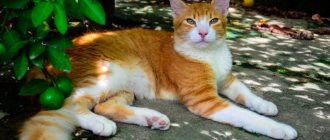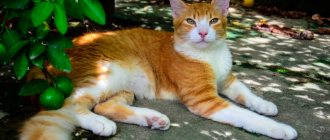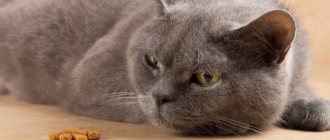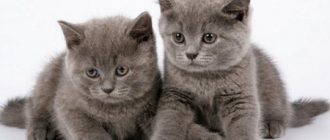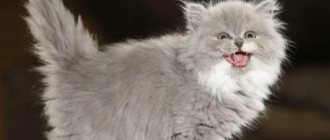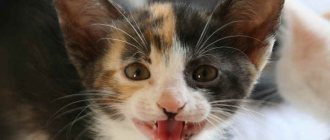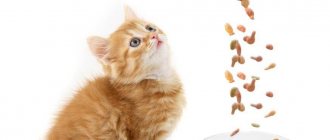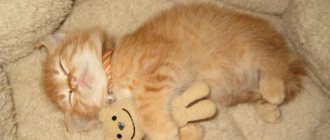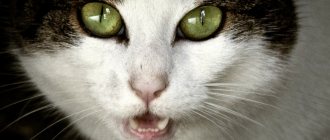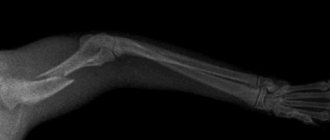Heavy breathing, like many other changes that occur in a pet’s body, causes concern among caring breeders. This is understandable, because the animal cannot talk about the pain or discomfort it experiences, so recognizing the problem in time and providing the necessary help is an important task for the owner. Let's figure out what could be the reasons why a kitten is breathing heavily and what to do if such a condition is detected.
What causes a cat to feel unwell?
Let's figure out why the cat doesn't eat for several days and constantly lies in one position. The following diseases may be the cause of poor health and unusual behavior:
- If a cat does not eat anything and at the same time has lost a lot of weight, then most likely he suffers from diseases of the gastrointestinal tract. These conditions are often accompanied by symptoms such as nausea and diarrhea. Only a veterinarian can diagnose the disease.
- Pathological changes in the liver are also characterized by similar changes in the behavior of the animal.
- A kitten may refuse to eat due to problems with the pancreas, as a result of which the production of enzymes involved in the process of digesting food is disrupted.
- Disturbances in the functioning of the genitourinary system.
- Diseases of the hematopoietic system.
- Damage to the mucous membranes of the oral cavity and upper respiratory tract.
- Chronic renal failure.
- Infectious processes in the body.
- Diabetes.
- Parasitic infections.
- Tumor formations in the stomach or esophagus.
A cat's poor appetite is not always a sign of a serious illness. It is possible that the cause of this condition is:
- Introduction of a new product to the menu. In this case, it is enough to reconsider the cat’s diet.
- Changing of the living place. In order for adaptation to take place as quickly as possible, you can purchase special medications at the veterinary pharmacy designed to get used to the new environment.
- Stressful situations. By identifying the irritant, you can help your pet.
A cat not eating during the day is not the most serious reason for concern. A mandatory reason to consult a doctor is a long-term refusal to eat (a week or more). In order to correctly assess the cat’s condition and seek qualified help in time, you must know some features of the cat’s body:
- A young and completely healthy cat can go without eating for about five days without any harm to its health. After this period, provided that the animal begins to eat properly, the necessary vitamin and mineral balance will be completely restored in its body.
- An older cat can live without food for about 3 days. If the reason for refusing food is not illness, then his health condition will not worsen.
- If a small kitten does not eat anything for a long time, then this is a reason to sound the alarm, as it may die. The baby's fragile body can, in rare cases, survive a day without food. Therefore, you should seek help even if your pet does not eat for half a day.
- Long-term abstinence from food is unacceptable for cats suffering from chronic diseases. Regardless of the type and stage of the disease, the fast should not last more than two days.
How to provide help at home?
With rhinotracheitis, cats do not stay in the clinic, but are sent home with the owner. To prevent your pet’s condition from worsening, carefully follow all the veterinarian’s recommendations. Under no circumstances treat a cat’s cough with “human” drugs to thin the sputum - this is very dangerous for the pet’s health.
In cases where a cat's eyes are affected by rhinotracheitis, it is prohibited to use any drops!
At home, it is necessary to provide the animal with:
- drinking plenty of water,
- balanced high-calorie diet,
- a cozy and warm place to relax,
- peace and quiet.
If the cat completely refuses to eat, then contact the veterinarian again - this is necessary to put on an IV and avoid the development of complications.
Physiologically caused shortness of breath
It is characterized by the fact that:
- is caused by natural processes of the body’s vital functions and does not require treatment;
- essentially represents a reaction to the influence of stress factors or unfavorable conditions, after which the respiratory process in the animal returns to normal.
Causes
A physiological respiratory disorder develops in an animal when:
- Psycho-emotional stress. It is accompanied by the release of a large amount of adrenaline into the blood, which stimulates the heart. The body's need for oxygen increases sharply. To compensate for its deficiency, the cat begins to breathe more often and deeper.
- Physical stress. When an animal runs a lot and quickly, the heart contracts more often, oxygen is consumed faster, so the cat breathes more actively than at rest. The same thing happens if the animal overheats.
- Stress due to chest injury. The injured pet, in addition to being frightened, experiences pain, which, if the ribs are broken, intensifies with breathing. Inhalations and exhalations become careful, superficial, and the animal’s mouth is open. The situation is critical and requires emergency measures.
Symptoms
We are talking about the behavior of a cat when shortness of breath can be explained by physiological reasons:
- the animal is worried about thirst and drinks a lot after active games and running;
- the pet becomes lethargic, looks for shade to hide and rest, and if it finds a wet surface, it lies down on it. This happens after a long stay in the heat. After a couple of hours, the cat comes to his senses, eats with pleasure and continues to lead an active lifestyle;
- the animal is restless and shows obvious signs of fright, one of which is dilated pupils. Perhaps you had to run away from the dog.
A cat's lethargic state indicates problems with the cat's health.
How to help a cat
She needs to be left alone, offered a bowl of fresh, cool water, and then given the opportunity to rest and sleep.
When should I worry?
Your cat's wheezing breathing is nothing to worry about. However, it is important to consult a veterinarian to determine the cause of this condition and provide treatment if necessary.
If you see any of the following symptoms along with wheezing, contact your veterinarian immediately.
- Having difficulty catching my breath
- Cough or choking
- Very pale or bluish gums
- Dripping/collection of mucus in the mouth
- Signs of distress (asthma attack)
- Prolonged wheezing
- Very lethargic
What to do if your cat is breathing heavily
So, there are quite a few reasons that can lead to respiratory problems in cats. What to do if the cat is breathing heavily: self-medicate or rather take your pet to the veterinary clinic?
First, you need to analyze whether heavy breathing is caused by harmless reasons (for example, a long hunt for a sparrow in the heat or fear of a car siren). If changes in breathing are understandable and short-term, there is no cause for concern. However, it is better to rush to the doctor if:
- The cat sticks out its tongue and breathes heavily for several hours or even days;
In addition to breathing problems, the cat also exhibits other dangerous symptoms (for example, fever, seizures, refusal to eat, etc.).
During a visit to the clinic, it is important for the owner of a cat who has suddenly begun to breathe heavily to tell the doctor about all warning signs. To make a diagnosis, a veterinarian may prescribe the animal to undergo a series of tests and studies (usually an X-ray, ultrasound, ECG, nasopharyngeal endoscopy, blood sampling, etc.) are required.
Treatment can be prescribed after a precise determination of the cause that led to respiratory disorders.
What is Neonatal Kitten Fading Syndrome? Techniques for managing severe neonates.
This syndrome is more described in puppies, less so in kittens.
Most often, this term has a reason - septicemia in newborn kittens, that is, the development of an infection in the body. Sometimes you can find the name “neonatal sepsis” or “newborn sepsis”.
Symptoms - refusal of milk, no sucking reflex - does not stick to the finger or nipple. Lethargic, inactive, unlike puppies, who constantly squeak, and kittens lie quietly and quickly develop disseminated intravascular coagulation syndrome, blood in the urine, nasal bleeding, vasodilation, impaired cardiac output, and septicemia.
Change in breathing due to worsening condition
If a kitten breathes with its mouth open, and quite often, this may be a sign of a health problem in the animal. The breathing rate can change if the body temperature is elevated, if the animal is in pain, if its body is overheated, hypothermic, or dehydrated. In case of overheating, the kitten breathes through its mouth quite often, but when it is hypothermic, on the contrary, it has barely perceptible breathing, in which the ribs and stomach practically do not change their position.
If abdominal breathing prevails in a kitten, this may be a symptom of a chronic pathology of internal systems and organs. With the help of the abdomen, a pet can breathe if its chest muscles, spine, lungs, or ribs are damaged. This happens because inhalation causes pain to the animal.
If any changes are observed in the animal's breathing, you should consult a veterinarian. The kitten should be taken to the clinic immediately if the pulse is weak or, conversely, rapid; mucous membranes have a blue or red tint; wheezing, whistling, gurgling and similar noises are heard in the chest; mucus is discharged from the nose or mouth; any other alarming phenomena are present.
Viruses, infections and organ diseases may be accompanied by some other signs, and an altered breathing rate is only an indirect symptom. Despite this, the owner of the animal must tell the veterinarian about all the occurring violations so that the specialist has the opportunity to make a diagnosis in a shorter time.
For example, frequent and noisy breathing, a dry cough and high body temperature may indicate that the pet has bronchitis. If the kitten is susceptible to allergies, then difficulty breathing may be a symptom of laryngeal edema.
If the general condition of the animal does not cause any particular concern, but the kitten definitely has some difficulty breathing, it is necessary to examine the oral cavity and larynx. There is a possibility that a foreign object could be stuck in the throat, which should be removed as soon as possible. Wheezing in the chest area may indicate that mucus has accumulated there, interfering with natural air circulation.
If your pet wheezes when breathing through the nose, and wheezing or whistling sounds are heard in the process, then there is a possibility of inflammation of the nasopharynx, so much so that air has difficulty entering the nose
Wheezing breathing is a sign that you should immediately pay attention to, because it can manifest itself in cases such as pneumonia, edema, diseases of the cardiovascular system. Heavy, rapid breathing in an animal can be a symptom of an injury that is not noticeable at first glance.
The kitten should be carefully examined, trying to find traces of the blow: bruises, wounds, bruises, torn fur. The fact that a pet is in pain can be easily understood by its behavior, which is expressed in apathy, constrained movements, poor appetite, and constant thirst.
Heavy, rapid breathing in an animal can be a symptom of an injury that is not noticeable at first glance. The kitten should be carefully examined, trying to find traces of the blow: bruises, wounds, bruises, torn fur. The fact that a pet is in pain can be easily understood by its behavior, which is expressed in apathy, constrained movements, poor appetite, and constant thirst.
It will be very helpful if someone else is nearby in this situation: one person can perform chest compressions, and the other will help with artificial ventilation. With this balance of power, the chances of saving the animal increase.
When to urgently contact a veterinarian
Many of these conditions are extremely dangerous and can lead to death. The success of treatment largely depends on how quickly treatment begins. In order not to miss the moment when treatment is possible, it is worth knowing the symptoms for which you need to show your pet to a doctor as soon as possible. This must be done if, in addition to rapid breathing, the following are observed:
- temperature increase;
- increased heart rate;
- wheezing in the chest;
- nasal discharge;
- discharge from the oral cavity;
- too pale or red tint of mucous membranes.
At what age and how to accustom a cat to brushing its teeth?
It is ideal if you start teaching your kitten to brush its teeth from childhood. Of course, it will not be possible to train a cat to open its mouth at the sight of a toothbrush. But over time he will understand that the procedure is inevitable.
If you have never done preventative cleaning, and your cat has dental problems, you will have to start brushing his teeth, even when the pet is already an adult.
Let's look at how to start brushing your cat's teeth using a four-week training program.
Week 1. The pet becomes familiar with the taste and smell of toothpaste and brush.
Squeeze a little paste onto the brush and place it next to your pet. Let the cat sniff and get acquainted with the new object. Let your pet lick the paste off your finger every day.
Week 2. Introduce toothpaste into the animal’s mouth with your finger.
This time, apply the toothpaste with your finger to one of the animal's teeth, gently lifting the upper lip.
Week 3. Introduce toothpaste with a brush.
Hold the brush in your hands and let your cat lick the toothpaste off the bristles.
Week 4. We brush our teeth with a brush.
Start brushing your teeth. Pull your lips back and insert the brush into the space between your cheek and gums. Act quickly before your pet gets impatient.
At each stage, associate the action with a reward. Choose a reward that your cat likes the most (for example, a favorite treat) and treat it after each treatment. This way the cat will understand that even if this is not the most pleasant action, then she will get something tasty.
To create a positive attitude, reward your cat with his favorite treat.
You only need to clean the outside of the mouth. On the inside, as a rule, there are no problems.
In order to clearly demonstrate the procedure, we invite you to watch the video. It is in English, but it shows all the steps we described above.
Treatment and prognosis
Treatment is prescribed after examination and diagnosis. Depending on the reasons that caused the breathing disorder, appropriate medical procedures will be carried out with the cat.
The doctor’s first task will be to eliminate hypoxia. For this purpose, if necessary, the cat will be connected to an artificial lung ventilation device (ALV). The animal is also given drugs intravenously that enrich the blood with oxygen.
Next, after the necessary hardware tests, the cause of suffocation is eliminated. Often it is necessary to resort to surgical intervention.
The prognosis for the pet’s recovery depends on the owner’s responsibility and effective actions. The faster the cat receives effective help, the more favorable the prospects for his recovery. It all depends on the severity of the animal’s condition at the time of treatment at the clinic.
When cats breathe with their mouths open too often without a “good reason,” this should alert the owner and prompt them to consult a professional. Even a congenital disease can be taken under control and exacerbations prevented. This way you can extend the life of your family pet and make it more enjoyable.
I like it I don't like it
Diagnostics
Having studied the external symptoms of cough, we proceed to diagnosis:
- conduct an external examination of the body, listen for wheezing and noises;
- evaluate cardiac activity;
- take blood for analysis;
- do an X-ray examination of the sternum;
- a culture of secretions or sputum is collected to identify the causative agent of inflammation;
- examine the affected organ for oncology (if suspected).
In clinics, it is possible to examine the entire animal’s body by different specialists and conduct an X-ray examination with a contrast agent.
Physiological reasons
In cats, as in humans, breathing through the nose is considered the physiological norm. It is not uncommon to see a cat breathing with its mouth open and its tongue hanging out like a dog. It is noticeable that with this method of breathing the abdominal muscles are involved: the cat breathes not from the chest, but from the stomach.
Nature has created a vacuum in the chest cavity around the lungs. When the pectoral muscles work while inhaling, the ribs diverge - the lungs straighten and fill with air, which enriches the blood with oxygen.
If there is a lack of oxygen, an “emergency” breathing mode is activated and the abdominal muscles are activated. The body tries to increase the amount of air inhaled - it increases breathing movements.
As soon as the oxygen level in the blood returns to normal, abdominal breathing “turns off” - the cat breathes calmly, through the chest, through the nose. If the animal does not have any pathological changes in the body, such conditions correspond to the norm and quickly pass when the negative factor is eliminated.
Natural external reasons why a cat breathes with its mouth open are:
- Hot. It is known that as the air temperature rises, the oxygen content decreases. The body's need for this element increases. The brain introduces a mode of “enhanced ventilation” - breathing becomes more frequent. Long-haired cats have a particularly hard time withstanding the heat: Maine Coons, Persians, Siberians. The owner's job is to keep the animal cool.
- Rapid breathing is often observed in cats that are obese. If a cat has suddenly gained weight, then you can often observe that the animal is breathing heavily with its mouth open. After the body adapts to the extra load or returns to normal (which is preferable), these phenomena disappear.
- After increased physical activity. Kittens are especially susceptible to this. Kids do not yet know how to regulate the load and after playing they get so tired that they “lay around without their hind legs” and often breathe with their mouths open and stick out their tongues. If the kitten breathes with an open mouth, then the reason for this may be irrepressible running and active play.
- Generic activity. During contractions and pushing, the uterus contracts, which limits the supply of oxygen to the organ. To avoid hypoxia in newborn kittens, the mother's body turns on increased breathing to protect the babies from suffocation. In this case, this is a necessary measure.
- The first time after giving birth and while feeding kittens, the cat may breathe rapidly with its mouth open, this is normal.
- Sexual hunting. During this period, the endocrine system of cats works in active mode: increased releases of sex hormones into the blood occur. Increased activity of the endocrine glands requires more oxygen - cats breathe frequently.
- Stressful situations. By frequent, heavy breathing with an open mouth, the animal’s body responds to psychological discomfort.
When these causes are eliminated, the cat quickly restores normal respiratory activity.
Why is a cat breathing heavily and frequently: non-dangerous reasons
Tachypnea, or rapid, heavy breathing, occurs in a cat when there is a lack of oxygen, or hypoxia. This condition is explained by 2 reasons: physiological and pathological.
Physiological causes are not life-threatening. These include various external and internal factors:
- Heat. A pet can overheat outside on a hot day or in a stuffy room with poor ventilation.
- Eating food quickly. Characteristic in the absence of saturation and prolonged fasting. Due to the too rapid absorption of food, breaths are taken in fits and starts, so the oxygen supplied with them is not enough.
- Fatigue after high physical activity. When performing intense movements, muscles require more oxygen, which is why shortness of breath often occurs while running.
- Overexcitement due to fear or aggression. In a state of stress, the body actively produces adrenaline, which speeds up the heart and the frequency of breathing. After calming down, the alarming symptoms disappear on their own.
- Hormonal changes. Occurs during estrus, pregnancy and childbirth. Treatment in these cases is not required, provided that the rest of the condition remains normal.
The risk group includes older cats and overweight cats. They get tired faster and often suffer from obesity due to inactivity.
Why does a cat have no voice?
The reasons why an animal lost its voice can be divided into three main groups:
- infectious diseases,
- non-communicable diseases,
- associated environmental factors.
One of the reasons for a cat’s loss of voice is infectious diseases of various etiologies: viral rhinotracheitis, infectious laryngitis, calcivirosis, rabies. With viral rhinotracheitis, the mucous membranes of the nose, throat and trachea are affected, which is accompanied by hoarseness or complete loss of voice in the sick animal. The causative agent of the disease is the herpes virus. Timely and proper treatment and dietary nutrition contribute to the rapid restoration of vocal function in a cat.
One of the common reasons why a cat has lost its voice is infectious laryngotracheitis, the causative agent of which belongs to the herpesvirus family. The disease is accompanied by inflammatory processes in the upper respiratory tract and laryngeal edema. These phenomena lead to hoarseness of the animal, as well as a complete absence of voice.
It hurts the cat to eat, drink water and meow. Infectious laryngotracheitis is often a consequence of advanced influenza, sore throat, colds, and rhinitis.
With viral calcivirus, one of the symptoms of the disease is hoarseness and loss of voice in the animal. This viral disease poses a deadly threat to small kittens and older animals. Symptoms of the disease are respiratory in nature. A sick pet has a hoarse voice and complete loss of voice. Ulcers are observed on the mucous membrane of the oral cavity, on the tongue, and on the tip of the nose. In severe cases, pneumonia develops.
Viral calcivirus in a cat: multiple ulcers filled with fluid on the tongue and palate
Silence of an animal can occur as a result of a dangerous disease for humans - rabies. This rare and fatal disease causes the cat to lose his voice due to paralysis of the pharynx and larynx. The animal does not speak, refuses to eat, there is drooling, hydrophobia and photophobia. The most effective prevention of a dangerous disease is timely vaccination of your pet.
One of the non-infectious reasons why a cat is hoarse is otitis media. The inflammatory process that occurs in the animal's middle ear leads to the development of edema of the laryngeal mucosa. In this case, the cat or cat loses its vocal abilities until the voice completely disappears.
The cause of swelling of the larynx and, as a result, hoarseness and loss of voice, may be an allergy. Allergic edema reduces the lumen of the larynx, complicating the animal’s vocal abilities.
Hoarseness of the voice and its complete disappearance are often observed when the pet’s body is dehydrated. Your pet should have free access to water at all times.
It is especially important to fulfill this condition when feeding your cat dry food.
Very often, the reasons why a cat has lost his voice, does not meow, or the animal’s voice is changed are injuries to the larynx, foreign objects in the oral cavity. The most common injury to a cat's larynx occurs with fish bones or inedible sharp objects. As a result of the penetration of a foreign body into the larynx, mechanical damage to the mucous membrane occurs, which is accompanied by swelling, which impedes vocal function.
Factors leading to loss of voice in an animal include:
- Keeping an animal in a room where there is frequent smoking. Cigarette smoke contains high levels of irritating toxic substances that can cause laryngeal swelling in your pet. In this case, the cat often has a hoarse voice.
- The dryness of the air in a room or apartment, especially during the heating season, provokes irritation and dryness of the laryngeal mucosa, hoarseness, and sometimes leads to a complete loss of the cat’s voice.
- Respiratory poisoning of an animal by toxic fumes from paint coatings, organic solvents, and disinfectants. Spraying household aerosols, cosmetics (varnishes, deodorants, etc.) can also cause hoarseness in a cat.
- After anesthesia, the animal may become hoarse for a short period of time.
Diagnosis of respiratory organs
Diagnostic methods in the clinic are aimed at identifying the causes of choking, coughing and shortness of breath and consist of:
- collecting anamnesis (finding out medical history). At this moment, the main role is assigned to the cat's owner. It is he who must tell about the signs, frequency, rhythm, strength of cough and shortness of breath, how long ago the first case was recorded, whether there is discharge and what other signs were recorded in the animal; • examination and palpation (oral and nasal cavity, trachea and esophagus, thoracic cells for integrity);
- auscultation (listening) of the bronchi and lungs;
- thermometry;
- if necessary, chest X-ray examination;
- performing endoscopy of the trachea;
- carrying out bacterial culture of nasal secretions for subtitration of microflora sensitivity to antibiotics;
- general blood analysis;
- blood chemistry;
- ultrasound examination of the chest cavity;
- analysis of fecal matter for worm eggs;
- thoracentesis (taking the contents of the chest cavity for examination).
Of all the listed diagnostic methods at home, you can carry out inspection, palpation, thermometry and auscultation. Often these methods are not sufficient to establish a diagnosis and prescribe treatment.
First aid
How to provide first aid to a cat if the situation becomes critical:
- First, secure the animal's body so that the neck is straight. Clean the animal's mouth with saliva and close it.
- After this, take a deep breath and exhale into the animal’s nose, while placing your hand folded in the form of a tube to its muzzle. You can cover your pet's face with a piece of cloth.
- If your pet's heart has stopped, it can still be saved. If artificial respiration does not produce results, you should perform a heart massage for 12-15 minutes. After this, the heart rhythm is restored.
- Wrap your hand around the animal's chest so that it is squeezed on both sides. In this case, the thumb should squeeze it on one side, and all the others on the other. The pet's chest area should be squeezed with your fingers 5 times, after which we need to blow air into the cat's nose. These steps are repeated until the heart rate and breathing return to normal.
If you react in time and do everything correctly, you will save your pet.
